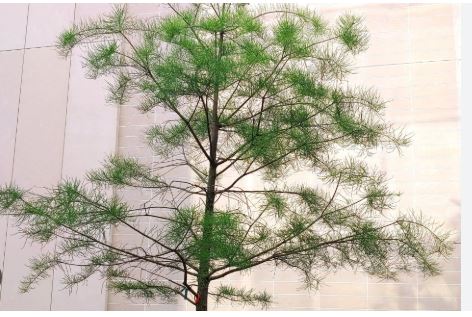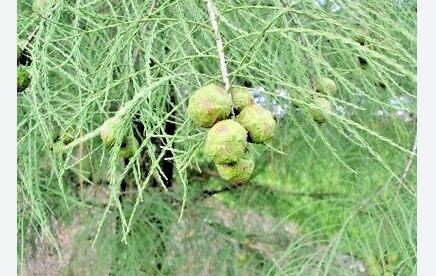
The Pond Cypress (Taxodium ascendens), a graceful deciduous conifer native to the southeastern United States, is a lesser-known but equally captivating relative of the Bald Cypress. Renowned for its slender, columnar form and delicate foliage that transforms into golden hues in fall, this tree thrives in wetland environments yet adapts beautifully to drier landscapes.
Its understated elegance and ecological contributions make it a valuable addition to gardens, restoration projects, and urban settings. In this detailed guide, we explore the botanical classification, origin, identifying characteristics, habitat, distribution, USDA hardiness zones, and diverse uses of the Pond Cypress.
Botanical Classification, Origin and Native Area
The Pond Cypress, scientifically named Taxodium ascendens, belongs to the Cupressaceae family, a group of coniferous trees and shrubs that includes cypresses, junipers, and cedars. It is classified within the genus Taxodium, alongside its close relative, the Bald Cypress (Taxodium distichum), and the Montezuma Cypress (Taxodium mucronatum).
The species name ascendens, meaning “ascending” in Latin, refers to its upright, narrowly conical growth habit. Historically considered a variety of the Bald Cypress (Taxodium distichum var. imbricarium), it is now recognized as a distinct species based on morphological and ecological differences. As a deciduous gymnosperm, it produces cones and sheds its needles annually, distinguishing it from most evergreen conifers in its family.
The Pond Cypress is native to the southeastern United States, with its primary range extending from southeastern Virginia through the Carolinas, Georgia, Florida, and westward to Alabama and Louisiana. It is particularly associated with the coastal plains of the Atlantic and Gulf regions, where it flourishes in isolated wetlands and pond margins.
Fossil evidence suggests that Taxodium species were widespread across North America millions of years ago, with the Pond Cypress evolving to occupy specific wetland niches. Indigenous communities in the Southeast utilized its wood for tools and construction, and its ecological role in stabilizing wetland soils has long been recognized. Today, it remains a vital component of southern wetland ecosystems, supporting biodiversity and water management.
Identifying Characteristics

The Pond Cypress is a medium-sized tree, typically growing 50–60 feet tall with a narrow, columnar crown that spreads only 10–20 feet wide, giving it a more compact silhouette than the Bald Cypress. Its trunk is often slightly buttressed in wet conditions, with reddish-brown, fibrous bark that peels in thin strips.
The soft, needle-like leaves are short (0.25–0.5 inches), tightly pressed against branchlets in an awl-like, overlapping pattern, unlike the feathery, two-ranked leaves of the Bald Cypress. In spring and summer, the foliage is bright green, turning a rich golden-brown or orange in fall before shedding. The tree produces small, round cones (0.5–1 inch), which are woody, purplish when young, and brown at maturity, disintegrating to release seeds.
Unlike the Bald Cypress, Pond Cypress rarely forms prominent “knees” (pneumatophores), though small root projections may appear in saturated soils. Its slender, upright form and delicate texture make it a striking landscape feature.
Habitat
The Pond Cypress thrives in wetland habitats, particularly in shallow ponds, depression marshes, and still-water swamps, where it tolerates prolonged inundation and nutrient-poor conditions. It is commonly found in cypress domes—circular wetland formations where taller trees grow at the center and shorter ones at the edges—alongside grasses, sedges, and other wetland species.
The tree prefers acidic, mucky, or sandy soils (pH 4.5–6.0) and is highly flood-tolerant, with roots adapted to oxygen-poor environments. It requires full sun (6+ hours daily) for optimal growth but can tolerate brief periods of shade. In cultivation, it adapts remarkably well to drier, upland soils, making it suitable for gardens and urban landscapes, provided drainage is adequate to prevent root rot in non-wetland settings.
Distribution
The Pond Cypress is distributed across the southeastern United States, with its core range spanning coastal regions from southeastern Virginia to southern Florida and westward to eastern Louisiana and southern Alabama. It is most abundant in Florida’s Everglades, Carolina bays, and Georgia’s Okefenokee Swamp, where it dominates wetland ecosystems.
Its range overlaps with the Bald Cypress but is more restricted to isolated, still-water habitats rather than riverine floodplains. Beyond its native range, it has been planted ornamentally in other parts of North America, particularly in the Midwest and Northeast, as well as in temperate regions of Europe and Asia. It is not invasive but can naturalize in suitable wetland environments. Conservation efforts focus on preserving its native habitats, threatened by drainage, development, and climate change.
USDA Hardiness Zones
The Pond Cypress thrives in USDA Hardiness Zones 5–9, tolerating minimum temperatures from -20°F (-29°C) to 20°F (-7°C). Its broad zone tolerance allows it to grow in diverse climates, from the cold winters of the Upper South to the humid, subtropical conditions of the Gulf Coast. In colder zones (5–6), mulching and proper siting protect young trees from frost damage, while in warmer zones (8–9), consistent moisture during establishment prevents drought stress. Its adaptability to both wet and dry conditions, once established, makes it a versatile choice for varied landscapes.
Uses
The Pond Cypress is a versatile tree with significant ecological, ornamental, and practical applications. In landscaping, its slender form, delicate foliage, and vivid fall color make it an excellent specimen tree, shade provider, or accent in gardens, parks, and urban settings. Its compact size suits smaller spaces compared to the larger Bald Cypress, and cultivars like ‘Nutans’ enhance its weeping, ornamental appeal.
Ecologically, it plays a critical role in wetland ecosystems, stabilizing soil, filtering water, and providing habitat for wildlife, including birds, frogs, and fish. Its roots reduce erosion in flood-prone areas, making it ideal for riparian restoration and stormwater management projects. The tree’s rot-resistant wood, though less harvested than Bald Cypress due to smaller trunk size, is used for specialty items like outdoor furniture, carvings, and mulch.
In urban environments, it mitigates runoff and improves air quality, thriving in rain gardens or along streets. Culturally, the Pond Cypress is valued in Southern landscapes for its connection to wetland heritage, symbolizing resilience and adaptability. Its low maintenance and aesthetic versatility make it a favorite for sustainable landscaping.
Cultivation of Pond Cypress (Taxodium ascendens)
Cultivating the Pond Cypress (Taxodium ascendens), a slender and elegant deciduous conifer native to the southeastern United States, offers gardeners, landscapers, and conservationists a versatile tree that thrives in both wetland and upland environments. With its delicate, golden fall foliage, compact columnar form, and ecological benefits, this close relative of the Bald Cypress is ideal for ornamental gardens, wetland restoration, or urban landscapes.
- Climate Suitability: Pond Cypress thrives in USDA Hardiness Zones 5–9, tolerating minimum temperatures from -20°F (-29°C) to 20°F (-7°C). It excels in humid, temperate to subtropical climates with warm summers and mild winters but adapts to colder regions with proper care. In Zone 5, protect young trees from severe frost to prevent damage to roots or branches.
- Site Selection: Choose a location with full sun exposure, receiving at least 6–8 hours of direct sunlight daily, to promote vigorous growth and vibrant fall color. While it tolerates light shade, full sun enhances its narrow, conical form. Ensure the site accommodates its mature size (50–60 feet tall, 10–20 feet wide) and suits wet or dry conditions.
- Soil Requirements: Plant in moist, acidic to neutral soil (pH 4.5–6.0), such as mucky, sandy, or loamy types. Pond Cypress is highly adaptable, thriving in saturated wetland soils or well-drained upland soils. In non-wetland settings, ensure good drainage to prevent root rot, and amend poor soils with organic matter (e.g., compost) for improved fertility.
- Planting Time: The best planting seasons are early spring or fall, allowing roots to establish before extreme heat or cold. Dig a hole twice as wide and as deep as the root ball, positioning the root collar at or slightly above ground level. Backfill with native soil, firm gently, and water deeply to settle the roots and eliminate air pockets.
- Watering Needs: Water young trees regularly (1–2 times weekly) for the first 1–2 years to establish a strong root system, keeping soil consistently moist but not waterlogged. Pond Cypress is flood-tolerant, enduring prolonged inundation, and drought-tolerant once established. In upland plantings, provide supplemental watering during extended dry periods to maintain health.
- Mulching: Apply a 2–3 inch layer of organic mulch (e.g., pine bark, wood chips) around the base, extending to the drip line but keeping it 2 inches from the trunk. Mulch conserves moisture, regulates soil temperature, and suppresses weeds, particularly beneficial for young trees in drier or urban sites. Replenish mulch annually to maintain its effectiveness.
- Fertilization: Fertilize young trees sparingly in early spring with a balanced, slow-release fertilizer (e.g., 10-10-10) to support healthy growth. Avoid over-fertilizing, which can cause weak, rapid growth or nutrient burn. Mature Pond Cypresses typically require no supplemental feeding in fertile or wetland soils, as they are adapted to low-nutrient environments.
- Pruning: Prune minimally to maintain shape or remove dead, damaged, or crossing branches, ideally in late winter or early spring before new growth begins. Use clean, sharp shears for precise cuts. The tree’s naturally narrow, columnar form requires little shaping, but light pruning can enhance structure for ornamental or urban settings.
- Pest and Disease Management: Monitor for pests like bagworms, spider mites, or cypress moths, treating infestations with insecticidal soap or neem oil. Pond Cypress is relatively disease-resistant but may develop fungal issues like twig blight in overly wet, poorly ventilated conditions. Ensure proper spacing and avoid overhead watering to minimize disease risk in upland plantings.
- Spacing: Space trees 10–20 feet apart to accommodate their mature spread (10–20 feet), ensuring adequate sunlight and air circulation to prevent fungal issues. For wetland restoration or dense plantings, closer spacing (8–12 feet) can mimic natural cypress domes. Consider their height (50–60 feet) when planting near buildings or utilities.
- Wind Protection: Young Pond Cypresses, with shallow roots, are susceptible to windthrow in exposed areas. Stake newly planted trees for the first 1–2 years using flexible ties to allow slight trunk movement, which strengthens roots. Remove stakes once established to encourage independent growth and long-term stability.
- Winter Care: In Zones 5–6, protect young trees from winter desiccation by mulching heavily around the base to insulate roots and watering adequately before freeze-up. In colder climates, wrap trunks with burlap to prevent frost cracking. Mature trees are cold-hardy and require minimal winter care, even in northern zones.
- Long-Term Growth: Pond Cypresses grow moderately fast (1–2 feet per year) under optimal conditions, reaching 50–60 feet at maturity with a lifespan of centuries. Their slender form, minimal knee formation (compared to Bald Cypress), and golden fall color make them ideal for wetland restoration, ornamental gardens, or urban rain gardens. Regular monitoring ensures ecological benefits and structural health.